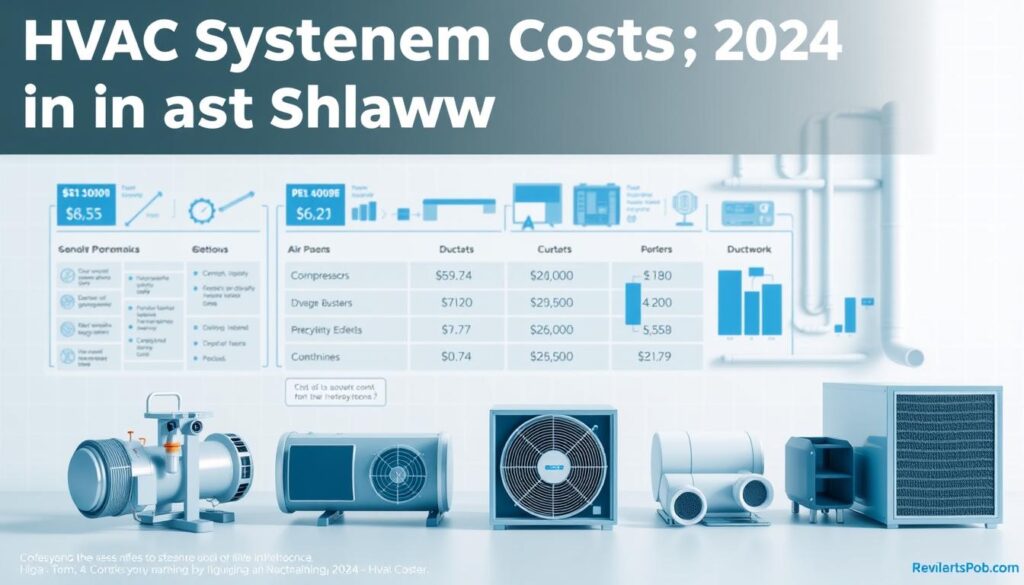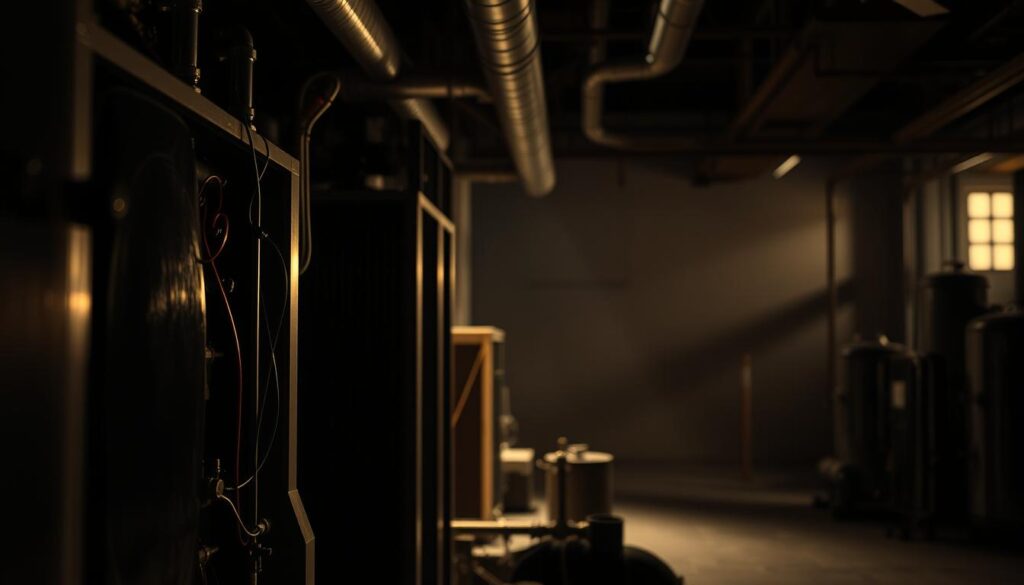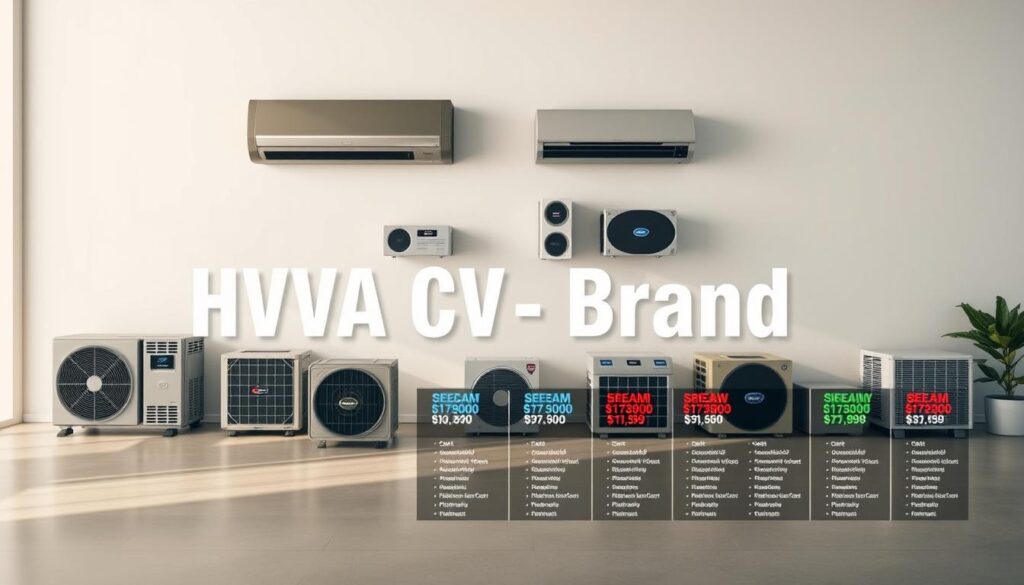Affiliate Disclosure
HVAC Guide Guys is a participant in the Amazon Services LLC Associates Program, an affiliate advertising program designed to provide a means for sites to earn advertising fees by advertising and linking to Amazon.
How Much Does a HVAC Cost? Are you curious about the cost to keep your home cozy this year? Figuring out HVAC system prices can seem like a puzzle. There are many options and costs to consider.

In 2024, homeowners might spend between $5,000 and $12,500 for a new HVAC system. The average price is about $7,500. But, several things can change how much you’ll pay for an HVAC system.
The cost of your HVAC system depends on several things. These include your home’s size, the system’s efficiency, how hard it is to install, and where you live. This guide will help you understand all about HVAC costs.
Key Takeaways
- HVAC replacement costs range from $5,000 to $12,500
- Average installation price is approximately $7,500
- Factors like home size and system efficiency impact pricing
- Regional variations can significantly affect HVAC system prices
- Energy-efficient models may cost more upfront but save money long-term
Table of Contents
Understanding HVAC System Basics and Costs Overview
When you think about getting an HVAC system for your home, knowing the basics is key. Modern heating, ventilation, and air conditioning systems come in many types. They help keep your home comfortable all year round.
There are many HVAC systems to pick from. Each has its own features and cost. Here are some options:
- Central Air Conditioners
- Furnaces
- Air-Source Heat Pumps
- Geothermal Heat Pumps
- Ductless Mini-Split Systems
- Boiler Systems
Exploring System Diversity
Every HVAC system has its own strengths and prices. Choosing the right one depends on your home’s needs, the climate, and your budget. Several things affect the cost of installing an HVAC system:
- Home size
- Local weather
- Energy efficiency needs
- Ductwork availability
- System complexity
Cost Range Insights
The cost of an HVAC unit varies a lot. It depends on the type and size of the system. You can find affordable options or high-efficiency systems that save energy in the long run.
Choosing the right HVAC system is not just about the upfront cost. It’s also about long-term comfort and saving energy.
How Much Does a HVAC Cost in 2024
Knowing the cost of a HVAC system is key for homeowners looking to upgrade or install in 2024. Prices vary based on several important factors that affect your total cost.
Your HVAC system’s cost usually falls into three main areas:
- Central Air Conditioning with Gas Furnace
- Heat Pump Systems
- Ductless Mini-Split Units
For a central air conditioning system with a gas furnace, expect these price ranges:
- Entry-Level Systems: $6,000 – $8,000
- Mid-Range Systems: $8,000 – $12,000
- Premium Systems: $12,000 – $16,000+
When looking at hvac equipment prices, remember that total costs depend on several things. These include your home’s size, existing ductwork, energy efficiency needs, and local installation complexity. Getting a professional assessment is key to finding the best value for your needs.
Pro tip: Always get multiple quotes and consider long-term energy savings when budgeting for your HVAC investment.
Explore Our HVAC Shop
Looking for top-rated HVAC tools, parts, and accessories? Visit our shop and find the perfect solution for your needs.
Visit the ShopHVAC Installation Cost Breakdown
Understanding the full scope of hvac installation cost helps you budget better for your home comfort upgrade. Breaking down the expenses shows where your investment goes and what factors affect the total price.
When planning an HVAC system installation, you’ll find three main cost categories. These categories make up the total investment:
- Equipment Costs (50-60% of Total Budget)
- Labor and Installation (30-40% of Total Budget)
- Additional Components (10-20% of Total Budget)
Equipment Investment Details
The largest part of your hvac contractor rates goes to buying the actual heating and cooling equipment. This includes the core system components like:
- Central air conditioning unit
- Furnace or heat pump
- Thermostat
- Refrigerant lines
Labor and Professional Installation
Skilled technicians ensure your system works efficiently. HVAC contractor rates for installation cover:
- System removal of old equipment
- Precise system sizing and placement
- Electrical connections
- Performance testing
Additional Essential Components
The final cost segment includes critical supporting elements for optimal system performance. These might involve ductwork modifications, electrical upgrades, or specialized mounting hardware.
Investing in quality installation can save you significant money on future repairs and energy costs.
System Size and Capacity Pricing
Choosing the right HVAC system size is key for your home’s comfort and energy use. Prices change a lot based on the system’s capacity. Your home’s size, insulation, and local weather affect the needed system size.
Looking at hvac unit cost, you’ll see different prices for different capacities. Smaller homes need less powerful units, while bigger homes need stronger ones.
- 1.5 to 2-ton units (small homes): Ideal for spaces up to 1,000 square feet
- 2.5 to 3.5-ton units (medium homes): Perfect for 1,000-1,500 square feet
- 4 to 5-ton units (large homes): Suitable for 1,500-2,500 square feet
Knowing your home’s needs is important for choosing the right HVAC system. Oversized or undersized units can lead to inefficient performance and higher energy costs.
| System Capacity | Home Size | Price Range |
|---|---|---|
| 1.5 to 2-ton | Up to 1,000 sq ft | $3,500 – $5,500 |
| 2.5 to 3.5-ton | 1,000-1,500 sq ft | $4,500 – $7,500 |
| 4 to 5-ton | 1,500-2,500 sq ft | $6,500 – $12,000 |
Professional HVAC contractors can guide you to the best system size for your home. Taking the time to pick the right capacity means better comfort and energy savings in the long run.
Explore Our HVAC Shop
Looking for top-rated HVAC tools, parts, and accessories? Visit our shop and find the perfect solution for your needs.
Visit the ShopEnergy Efficiency Ratings and Cost Impact
Understanding energy efficiency ratings is key when looking at hvac equipment prices. It helps find affordable hvac solutions. Your HVAC system’s efficiency affects both your initial cost and long-term expenses.
Energy efficiency in HVAC systems is measured by special ratings. These ratings help you choose the right system. They show how much energy your system will use and how much you’ll save over time.
SEER Ratings Explained
SEER (Seasonal Energy Efficiency Ratio) measures cooling system efficiency. Higher SEER ratings mean better performance and less energy use. Here’s a quick overview:
- Standard Efficiency: 14-16 SEER (Basic performance)
- High Efficiency: 17-21 SEER (Improved energy savings)
- Premium Efficiency: 22+ SEER (Maximum energy conservation)
AFUE Ratings for Heating Systems
AFUE (Annual Fuel Utilization Efficiency) shows how much fuel is turned into heat for heating systems. A higher AFUE percentage means more efficient heating and lower bills.
Long-term Cost Benefits
High-efficiency HVAC systems cost more at first, but save money in the long run. They can cut your annual utility bills by 20-40%. This makes them a wise financial choice.
“Efficiency is the key to sustainable home comfort and reduced energy expenses.” – HVAC Energy Experts
Hidden Costs and Additional Expenses

When planning for HVAC installation, homeowners often miss important costs. These can greatly affect the total price. Knowing about these hidden costs helps you budget better and avoid surprises.
Additional expenses can make your HVAC replacement more costly. Key areas to think about include:
- Ductwork modifications or complete replacement
- Electrical system upgrades
- Structural modifications
- Permits and inspection fees
Ductwork repairs can cost from $300 for small fixes to $6,000 for a full replacement. Electrical updates might add $500 to $2,000, depending on what’s needed.
“Always budget 10-15% extra for unexpected HVAC installation expenses to prevent financial strain.”
Zoning systems offer customized temperature control in different areas. They add complexity and cost but can save energy and improve comfort over time.
Professional HVAC contractors can spot and prepare for these extra costs during initial talks. Asking for a detailed assessment ensures you know the full cost of your project.
Explore Our HVAC Shop
Looking for top-rated HVAC tools, parts, and accessories? Visit our shop and find the perfect solution for your needs.
Visit the ShopPremium vs Standard HVAC Options
When looking at hvac system prices, you’ll find many choices. These options cater to different budgets and needs. Knowing the differences between basic, mid-range, and high-end HVAC systems helps you choose wisely for your home.
The cost of your HVAC equipment changes with its complexity and features. Here’s a look at the main options:
Entry-Level Systems
For those on a tight budget, there are affordable HVAC systems. These basic options include:
- Basic temperature control
- Standard efficiency ratings
- Lower initial investment
Mid-Range Options
Mid-range systems offer better performance and energy savings. Their prices reflect more advanced tech:
- Better comfort features
- Higher SEER ratings
- More consistent temperature management
High-End Solutions
Premium HVAC systems are the top choice for home comfort. With higher prices, they include:
- Advanced zoning capabilities
- Highest energy efficiency ratings
- Smart home integration
| System Level | Price Range | Key Features |
|---|---|---|
| Entry-Level | $6,000 – $8,000 | Basic functionality, standard efficiency |
| Mid-Range | $8,000 – $12,000 | Improved performance, better comfort |
| High-End | $12,000 – $16,000+ | Advanced technology, smart features |
Pro Tip: Think about your long-term comfort and energy savings when picking an HVAC system. Even though premium options are pricier, they offer big benefits in efficiency and comfort.
Regional Price Variations and Seasonal Factors
When you look into the cost of a hvac system, you’ll see prices vary across the U.S. Your location greatly affects HVAC contractor rates and installation costs.
Prices for HVAC systems change a lot depending on where you are. Places like New York City, San Francisco, and Los Angeles usually cost more. This is because of several factors:
- Local labor market rates
- Cost of living differences
- Climate zone requirements
- Local building code regulations
Seasonal timing also affects HVAC prices. Strategic planning can help you save money:
- Off-peak seasons (spring and fall) often have lower installation rates
- Winter and summer months have higher demand and prices
- Booking installations in shoulder seasons can save up to 20% on hvac contractor rates
“Understanding regional and seasonal price dynamics can help homeowners make more informed HVAC investment decisions.” – HVAC Industry Expert
Your area’s climate affects the type of HVAC system you need. Southern states need cooling-focused systems, while Northern regions need strong heating systems.
Explore Our HVAC Shop
Looking for top-rated HVAC tools, parts, and accessories? Visit our shop and find the perfect solution for your needs.
Visit the ShopHVAC Brand Comparison and Pricing
Choosing the right HVAC brand is more than just looking at prices. It’s about making a long-term investment. You need to think about how well the system will perform and last over time.

When you’re looking at HVAC manufacturers, there are key things to consider. These factors help you understand the real value of your system.
Top Manufacturer Pricing Insights
- Carrier: Premium pricing with reliable performance
- Trane: High-end systems with robust engineering
- Lennox: Energy-efficient options with competitive pricing
- Rheem: Budget-friendly solutions with solid warranties
Warranty Coverage Strategies
Warranty protection varies among manufacturers. Make sure to review warranty terms to know what’s covered and for how long. Some brands offer:
- Standard 5-10 year parts coverage
- Extended warranty options
- Registration-based additional protection
Brand Reliability Assessment
The life of your HVAC system depends on the manufacturer’s reputation. Top brands spend a lot on research, testing, and customer support. Look for brands with:
- Consistent positive customer reviews
- Strong technical support networks
- Proven track records of system durability
Don’t just look for the cheapest prices. The best value comes from a reputable brand that offers good performance, efficiency, and cost.
Maintenance Costs and Long-term Investment
Buying an HVAC system is more than just the upfront cost. Knowing about hvac maintenance costs helps keep your home safe and running well for years.
Keeping your HVAC system in check is key to making it last longer. Experts say to get it checked by pros at least twice a year. This helps avoid costly repairs and breakdowns.
- Annual professional maintenance: $150-$300
- Basic filter replacements: $10-$50 per filter
- Comprehensive system tune-up: $80-$250
Your HVAC system is a big part of your home. Regular upkeep can add 5 years to its life, saving you from expensive new system costs.
| Maintenance Type | Estimated Cost | Frequency |
|---|---|---|
| Air Filter Replacement | $10-$50 | Every 3 months |
| Professional Inspection | $150-$300 | Annually |
| Minor Repairs | $100-$600 | As needed |
“An ounce of prevention is worth a pound of cure” – this is true for HVAC systems too.
Ignoring regular maintenance can cause more damage and cost you more in repairs. Regular care keeps you comfortable and saves money.
Explore Our HVAC Shop
Looking for top-rated HVAC tools, parts, and accessories? Visit our shop and find the perfect solution for your needs.
Visit the ShopWays to Save on HVAC Installation
Lowering your HVAC installation cost doesn’t mean you have to sacrifice quality. Smart homeowners can find ways to save money on their HVAC investment. They do this by using smart strategies.
When you schedule your HVAC system replacement, timing is everything. Installing it during off-peak seasons like fall or early spring can save you a lot. Contractors often give discounts during these times because there’s less demand.
- Research seasonal promotions from local HVAC providers
- Check manufacturer rebate programs
- Explore energy efficiency tax credits
Smart financial planning can cut down your upfront costs. Here are some tips to save money:
- Get quotes from several trusted contractors
- Look at the long-term costs, not just the initial price
- Look into financing options with low interest rates
“The smartest HVAC investment balances immediate affordability with future energy efficiency.”
Government incentives can help lower your HVAC installation cost. The federal government offers tax credits for installing energy-efficient systems. This can save you hundreds of dollars. Also, check out the current Energy Star rebate programs for more savings.
Your local utility company might offer money for upgrading to efficient HVAC systems. These programs help make affordable HVAC solutions more available for those on a budget.
Conclusion
Understanding HVAC costs can seem daunting. But knowing your options makes it easier. When you think about the cost of a HVAC system, remember it’s not just the price. The right system offers both upfront savings and long-term comfort.
When looking at HVAC replacement costs, consider several things. These include system performance, energy ratings, and your home’s climate. Professional installers can guide you in choosing the best system for your home.
Smart homeowners look at more than just the cost. They think about energy savings and system reliability. This approach helps you get the most value from your investment.
To save money, compare quotes, look for energy rebates, and choose efficient models. Quality installation and regular maintenance also extend your system’s life. This way, you create a comfortable home while keeping costs in check.
Your HVAC system is a big investment in your home’s comfort and efficiency. Take your time to research and consult experts. Make a choice that fits your needs and budget.

